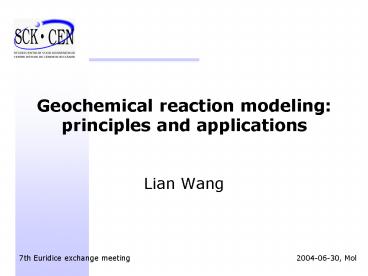Geochemical reaction modeling: principles and applications PowerPoint PPT Presentation
1 / 24
Title: Geochemical reaction modeling: principles and applications
1
Geochemical reaction modeling principles and
applications
- Lian Wang
7th Euridice exchange meeting
2004-06-30, Mol
2
Model, modeling, computer simulation
- Model
- A testable idea, hypothesis, theory
- Modeling
- An action using a model to interpret and/or
predict processes/phenomena - Computer simulation
- Modeling with computers
3
Contents
- Principles
- Mass action and mass balance laws
- Speciation the key to identify geochemical
processes - Applications
- Modeling Boom Clay pore water
- Modeling Boom Clay oxidation phenomena
4
Principleschemical thermodynamics
Energy
5
Principles a system evolves spontaneously to a
lower energy level
Oxidation of Boom Clay
- Pyrite (FeS2) H2O 3.5O2
- 2H 2SO42- Fe2
- System constraints
- Mass action
- G0-G0?G0 -RT lnK
- Mass balance
A
energy
B
Database 1768 species, 1121 minerals, 93 gases,
ion exchange, sorption, OM
6
Chemical speciation
- Speciation
- the distribution of a chemical component among
minerals, species, and gases - A chemical component can exist in different forms
and change from one to the other - Chromium Cr Cr(III) nutrient, Cr(VI) toxic
7
Speciation the key to identify geochemical
processes
- Clay dissolution by an alkaline plume
- Smet 4.68OH- 1.34H2O .33Mg2 .33Na
1.67AlO2- 4HSiO3- - Smet .62H2O .68OH- 1.5Na .21AlO2-
.33Mg2 1.961Analcime - Nature is a highly coupled, non-linear system...
- Certain level of understanding...
8
Application (1) Boom Clay reference model
- To understand the present-day BC composition by
studying the mineralogy and the pore water
composition and their interrelationships - The start point for
- Modeling the BC evolutions
- Predict the effects of perturbations
- Chemical conditions for experiments
9
BC reference model pore water sampling
12 filters -212 to -237 m
10
BC reference modelvariations in concentrations
- Major ions
- Na 348431 mg/l
- Ca 1.52.9
- K 6.78.3
- Mg 1.32.6
- Fe 0.10.7
- SO4 0.62.3
- TIC 173206, pH 8.2 (lab.), pCO2 ?
- Trace ion
- Sr 30 ppb 30 ppm
11
BC reference modelplausible interpretations
the driving force Calcite H Ca2 HCO3-
-
Na K Mg2
Boom Clay
-
-
-
Na K Mg2
siderite H Fe2 HCO3-
Pyrite H2O 3.5 O2 Fe2 2 H 2 SO42-
12
BC reference modelwhy the solubility of calcite
vary?
- Calcite (CaCO3) H Ca2 HCO3-
- pH variation is likely the cause
- However, pH is related pCO2 and difficult to
measure - H HCO3- CO2 (g) H20
Boom Clay
pCO2 10-2.5
pCO2 10-3.5
Pore water
13
BC reference model calculate the pH based on
measured water compositions
Calcite (CaCO3) saturation SI 0 Alkalinity
conservative quantity
Constraints
14
BC reference model results (1)
- System variable
- pH 8.3 to 8.6
- Ca calcite solu.
- CaCO3 H
- Ca2 HCO3-
- Na, K, Mg ion exchange, e.g.,
- clay-Mg Ca2
- clay-Ca Mg2
15
BC reference model results (2)
- Boom Clay redox is controlled by the
pyrite-siderite boundary - Eh lt -270 mV for non disturbed clay
16
Application Oxidation of BC
- Some water samples have 10 to 20 kppm sulphate
comparing to 1 ppm normally found in
non-disturbed Boom Clay - Can the observation be explained?
- Excellent dataset to verify the BC reference model
17
Application Oxidation of BC Possible processes
- Pyrite H2O 3.5 O2
- 2H 2SO42- Fe2
- Calcite dissolves due to the decreased pH
- Calcite 2H Ca2 CO2 H2O
- Ca exchange Na, K, Mg from clay
- Siderite (Fe) and Chalcedony (Si) dissolution
18
application Oxidation of BC Model simulation on
pH and DIC
- pCO2 is a variable considering a partly open
system - pH drops due to the oxidation of pyrite
19
application Oxidation of BC Model simulation on
Ca and Na
- Pyrite H2O 3.5 O2 2H 2SO42- Fe2
- Calcite 2H Ca2 CO2 H2O
- Clay-Na Ca2
- Clay-Ca Na
20
Application Oxidation of BC Model simulation on
Mg and Fe
- Clay-Mg Ca2
- Clay-Ca Mg2
- Siderite H Fe2 HCO3-
21
Application Oxidation of BC Model simulation on
K and Si
- Clay-K Ca2
- Clay-Ca K
- Chalcedony SiO2(aq)
22
Application Oxidation of BC Sr distribution
(trace RN)
- Not a sorption
- Clay-Ca Sr2
- Clay-Sr Ca2
- KC 1
- But a solubility
- SrCO3(s) H Sr2 HCO3-
23
Sr distribution message to PA
- use a linear, reversible Kd model will
underestimate the reduction on the safety caused
by the oxidation of BC - When a solubility controlling phase is present,
the retardation of RN is controlled by isotopic
exchange, not sorption
10-7 M
10-7 M
Ca 88Sr Na K Mg
90Sr
88Sr
- - - -
SrCO3
24
- Mathematics and thermodynamics deal with models
of reality, not with reality itself - G.M. Anderson D.A. Crerar

